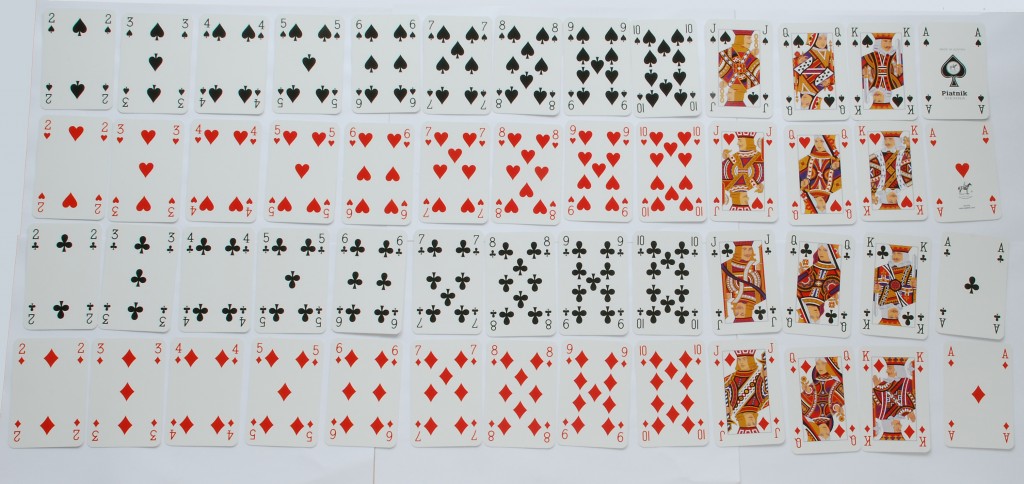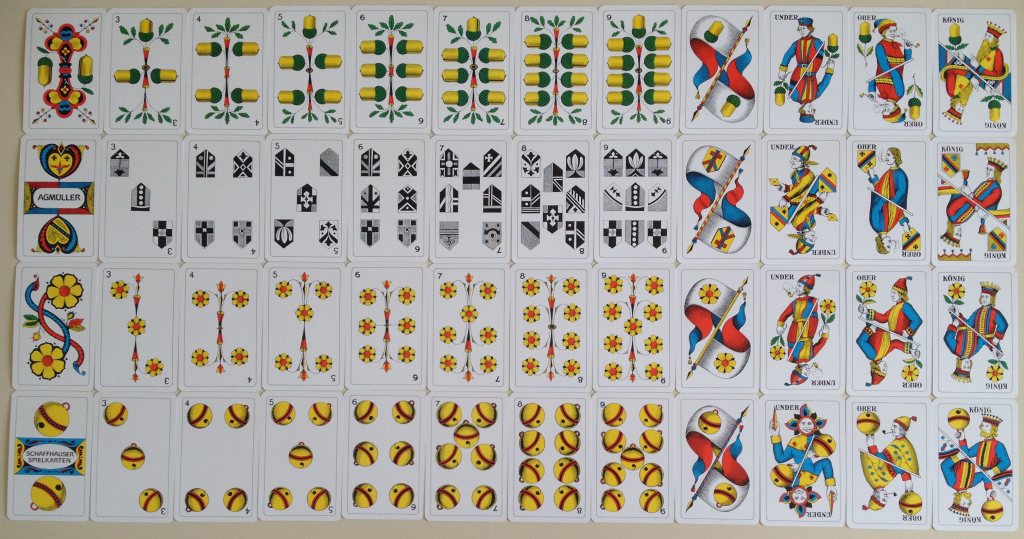
Card Symbols and Image Meanings
Interestingly, all cards with pictures depicted real historical heroes, kings, nobles, and rulers. The King of Hearts is Charlemagne, the King of Diamonds is Julius Caesar, the King of Clubs is Alexander the Great, and the King of Spades is the famous Biblical figure David.
By the way, the King of Hearts is the only one depicted without a mustache and is also called the suicide king because, unlike the other three kings who hold a sword, this one appears to have the sword pointed at and seemingly stabbed into his own head.
The queens in the deck are also notable figures. The Queen of Hearts is Queen Regina, the Queen of Diamonds is Queen Rachel – a historical figure from the Hebrew Bible, the Queen of Clubs is Queen Regina, and the Queen of Spades is Judith – a figure from the Bible.
The Jack of Hearts is Lancelot, the most trusted knight of King Arthur, the Jack of Diamonds is Hector – a Trojan prince from Greek mythology, the Jack of Clubs is La Hire – a commander in the Hundred Years' War, and the Jack of Spades is Ogier the Dane.
The value of cards depends on their rank and the rules of the game. An Ace can be either the highest or the lowest value card. Typically, cards are ranked as follows: (A), 2, 3, 4, 5, 6, 7, 8, 9, 10, J, Q, K, (A).
Cards of the same rank are called equal. However, there are games where the card hierarchy is different, depending on the specific game rules. For example, in the game “Thousand,” the ten is the second card after the ace and is considered higher than other face cards – the jack, queen, and king. There are other hierarchy variations as well.
Where is the Most Reliable Place to Play?
Classic Deck of Cards
The standard deck of cards we play with today was first created by the French artist Agen. The 52 cards in the deck represented the number of weeks in a year, and the 4 suits represented the seasons. Cards were and are usually made from special paper or plastic.
A certain set of cards is called a deck. Depending on the type of game, it consists of various numbers of cards, for example, 24, 26, 32, 36, 40, 48, 52-56, 106, 110 cards, etc.
Card Names
Diamonds (usually marked with red diamonds);
Hearts, also known as hearts, reds, or red ones (marked with red hearts);
Spades, also known as spades, leaves (marked with black leaf-shaped symbols);
Clubs, also known as clubs, acorns (marked with clover leaf-shaped symbols).
In different countries, they can look quite different. For example, in Switzerland, card symbols are depicted differently – shields, roses, bells, acorns. In Germany, card families are marked with hearts, bells, leaves, and acorns symbols.
In Southern Europe – Spain or Western Italy – with cups, coins, clubs, and swords, while in the Adriatic region of Italy – with coins, swords, cups, and batons.
Many of these cards stand out with their unique, antique appearance and are similar to the first European cards.
Returning to card families, it is important to mention that each card has a different rank. This can be identified by the picture, number, or letter indicated in the corner of the card, next to the suit symbol.
According to rank, cards are divided into number cards and court cards, or face cards.
Number Cards:
- Twos
- Threes
- Fours
- Fives
- Sixes
- Sevens
- Eights
- Nines
- Tens
Court Cards:
- Jacks (also called knaves or boys) marked with the letter J.
- Queens (also called maidens) marked with the letter Q.
- Kings marked with the letter K.
Ace, the thirteenth card of the family, is marked with the letter A.
Deck Composition and Design
In addition to the usual 52 cards, the set also includes 2 or 4 special cards – commonly called jokers (in English joker – jester).
The purpose of these cards depends on the game rules – they can be used in place of other deck cards or have the highest power (highest rank).
According to the history of these cards, it matches the origin of other face cards. As mentioned earlier, cards were initially intended for the entertainment of the nobility and can be said to reflect the hierarchy of the nobility at that time: kings, queens, knights, and jacks.
History recalls that most courts had jesters who had more rights than ordinary courtiers. Jesters not only entertained the participants of feasts but often even mocked their lords.
Note!
Cards are also of two colors – spades and clubs are black, while hearts and diamonds are red.
Modern card manufacturers, aiming for advertising and higher profits, try to attract players by releasing cards with symbols of different colors.

For example, well-known German and Swiss cards have symbols that are not black and red but four different colors – black, red, green, and blue. Cards released in the USA have the familiar black – spades and clubs – in red and vice versa – hearts and diamonds – in black.
The most widespread cards, for the convenience of players, have pictures drawn symmetrically, in a mirror principle, so that the cards have no top or bottom, and when holding the card in hand, it looks the same from all sides.
Usually, cards are made in a rectangular shape, about 60×90 mm in size. Smaller cards – about 40×60 mm, called patience cards, are also widespread.
However, for advertising and commercial purposes, cards can be made in various formats: round, oval, or even in the shapes of different objects – fish, Christmas trees, hearts, mummies, stars, etc.
Historical Cards
First Chinese Cards
In ancient China, cards were quite different from what we know today. They were elongated, about 5.5 cm in height and 1.5 cm in width, and narrower. They depicted various, often incomprehensible and insignificant symbols, legendary creatures. The oldest ones date back to 1120 AD.
Indian Cards
Indian cards are very similar to Romani cards. Rectangular or circular, painted in bright colors and decorated with gold. A deck consists of 7 or 8 families, each containing 12 cards (a king, a vizier, and 10 numbered cards). The families are also marked with swords, bells, Kabbalah talismans, pagodas, ivory sculptures, and other symbols. Similar cards, likely originating from Indian ones, were also found in the Persian Empire.
Arabic Cards

Arabic cards typically depicted a ruler and his subordinate – the vizier. Europeans replaced them with their own rulers – kings or emperors and knights – senior and junior. The latter was depicted as a squire or foot soldier, while the senior knight was often depicted as a rider.
Egyptian Cards
Sources found in Basel in 1377 mention a new phenomenon – a deck of cards: “In a typical deck, there are four kings sitting on thrones, each holding a different symbol… After the king come two marshals. They also have symbols, but one is inverted. Then come 10 numbered cards, marked with dots from one to ten. In total, there are 52 cards in the deck.” It is believed that this refers to an Egyptian deck of cards, which was popular among slave soldiers.
German and Swiss Cards

From Spain and Italy, cards spread to Switzerland and Germany, but again they were quite different. Instead of the king's (ruler's) assistant, there were senior and junior knight cards. The knights could be distinguished by how they held the coat of arms – the senior knight held it raised above, while the junior knight held it lowered below.
French Cards
It was only later understood that the most important aspect of cards was not the colors and beautiful patterns, but the symbol indicating the card's value. The French were the first to standardize cards, followed by the English. The symbols of French cards were established at the end of the 15th century.
Numbered cards were very easy to produce – only a few stencils were needed. More work was required for court cards, but there were only 12 in a French deck. Among them, the queen appeared, taking the place of the senior knight.
It is important to mention an interesting stage in the history of cards, that in ancient times not all cards had queens.
In Italian, Spanish, Swiss, and German decks, you won't find queens even today. The “discrimination” of female cards is said to be related to the history of cards.
Souvenir Cards
In ancient times, the nobility greatly enjoyed very elegant, intricate cards that even resembled works of art, which were more suitable for admiration than for playing games.
For example, the numbered card we are familiar with today depicted a full-length drawn maiden, the queen – a large coat of arms with a crown and three different shields, the jack – knights sitting around a table. The cards were not only red or black – the card families were marked by realistically drawn symbols of other colors.
In the 19th century, unique sets began to be produced, depicting aristocrats, cultural, political, literary figures, or even historical persons. Such cards were merely fashionable souvenirs.
In the world's card museums, there are preserved wooden cards, cards painted on plant leaves, and more. There are known card sets on beer caps or beer mug coasters, on plastic blocks (like dominoes), and more. Cards have even been released on gold foil.
Interesting Facts About Cards
Card Production.
In Erlanger, Kentucky, “The United States Playing Card Company” (USPCC) is one of the largest playing card manufacturers in the world. Founded in 1867, it produces such famous brands as “Bicycle,” “Bee,” “Tally-Ho,” “Congress,” “Hoyle,” “Aviator,” “Aristocrat,” and KEM.
Annual Production – USPCC produces more than 100 million decks of cards annually, which is almost two decks per American child per year.
World War II Escape Aid
Special Cards – During World War II, the U.S. government sent decks of cards with hidden maps to prisoners of war. By peeling off the backs of the cards, prisoners could find escape routes.
Shuffling Combinations
There are 80,658,175,175,170,943,878,571,660,660,636,856,403,766,975,975,289,505,440,440,883,277,824,000,000,000,000 possible ways to shuffle a deck of cards. This number exceeds all the atoms on Earth and the known stars in the Universe.
Hidden Eight
8 of Diamonds – The “8 of Diamonds” card has a hidden number eight in the white space. By squinting, you can see the eight.





